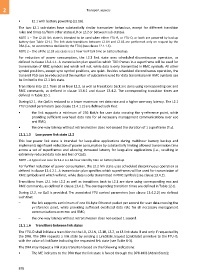Page 886 - 5G Basics - Core Network Aspects
P. 886
2 Transport aspects
• L2.1 with battery powering (L2.1B).
The two L2.1 sub-states have substantially similar transceiver behaviour, except for different transition
rules and times to/from other states (L0 or L2.2 or between sub-states).
NOTE 1 – The L2.1B link state is intended to be used when either FTU-R, or FTU-O, or both are powered by backup
battery (see Table 12-1). The link state transitions between L2.1N and L2.1B are performed only on request by the
DRA (i.e., no autonomous decision by the FTUs) (see clause 12.1.1.6).
NOTE 2 – One of the L2.1B use cases is a 2-hour VoIP talk time on battery backup.
For reduction of power consumption, the L2.1 link state uses scheduled discontinuous operation, as
defined in clause 13.4.1.1. A transmission plan specifies which TDD frames in a superframe will be used for
transmission of RMC symbols and which will not, while data is only transmitted in RMC symbols. All other
symbol positions, except sync symbol positions, are quiet. Besides scheduled discontinuous operation, the
transmit PSD can be reduced and the number of subcarriers used for data transmission in RMC symbols can
be limited in the L2.1 link state.
Transitions into L2.1 from L0 or from L2.2, as well as transitions back are done using corresponding eoc and
RMC commands, as defined in clause 13.4.1 and clause 13.4.2. The corresponding transition times are
defined in Table 12-1.
During L2.1, the QoS is reduced to a lower maximum net data rate and a higher one-way latency. The L2.1
FTU control parameters (see clause 13.4.1.2) are defined such that:
• the link supports a minimum of 256 kbit/s for user data crossing the γ-reference point, while
providing sufficient overhead data rate for all necessary management communications over eoc
and RMC;
• the one-way latency without retransmission does not exceed the duration of 1 superframe (TSF).
12.1.1.5 Low power link state L2.2
This low power link state is intended for keep-alive applications during multihour battery backup and
implements significant reduction of power consumption by substantially limiting allowed transmission time
across a set of superframes and allowing increased latency for keep-alive applications (i.e., resulting in
extremely reduced data rate and loss of QoS).
NOTE – A typical use case for L2.2 is a 48-hour standby time on battery backup.
For further reduction of power consumption, the L2.2 link state uses scheduled discontinuous operation as
defined in clause 13.4.2.1. A transmission plan specifies which superframes will be used for transmission of
RMC symbols and which will not, while data is only transmitted in RMC symbols (see clause 13.4.2).
Transitions from L2.1 into L2.2 as well as transitions back to L2.1 are done using corresponding eoc and
RMC commands, as defined in clause 13.4.2. The corresponding transition times are defined in Table 12-1.
During L2.2, no QoS is provided. The associated FTU control parameters (see clause 13.4.2.2) are defined
such that:
– the link supports a minimum of one 64-byte Ethernet packet per second for user data crossing the
γ-reference point, while providing sufficient overhead data rate for all necessary management
communications over eoc and RMC;
– the one-way latency without retransmission does not exceed 1 second.
12.1.1.6 Transitions between link states
The FTU-O shall initiate a transition to the L0, L2.1N, L2.1B, L2.2, or L3 link state if and only if requested by
the DRA. The DRA requests a link state by sending a LinkState.request (LinkState) primitive to the FTU-O,
with the value of LinkState indicating the requested link state (see Table 8-3).
The DRA may request a link state transition based on the following indications:
• The ME indicates to the DRA that the link state is forced through the DPU-MIB (AdminState);
876

